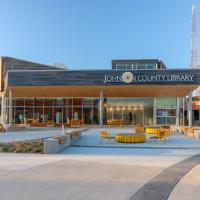Johnson County Library achieved another milestone in its seven-decade history with the March 20 opening of its newest branch, Merriam Plaza Library. This beautiful facility is co-located on a campus with the Merriam Community Center in the 6000 block of Slater Street.
The 15,000-square-foot branch replaced the much-loved but outdated Antioch Library, which had served Johnson County since the 1950s at the corner of Antioch Road and Shawnee Mission Parkway.
The new building is just a few blocks from the Antioch location and has Antioch’s same staff and collection. In fact, nearly 450 people, including Library-loving patrons and employees past and present, lined up shoulder-to-shoulder over about 1/3 mile on March 2 for a marvelous Slater Street Storybook Relay. They passed 58 items from Antioch to Merriam Plaza, the last of the Library collection to make the journey.
The Library and community center entrances face each other across a courtyard. The two facilities share a parking structure and a welcoming outdoor gathering space. Merriam leaders pitched the many benefits of a shared campus to Library officials in 2017, beginning a partnership to create this distinctive jewel and destination in the heart of the community.
At the March 20 grand opening, Merriam Mayor Bob Pape said patrons can nourish their minds at the Library and then work on their physical fitness at the community center right next door.
“It’s kind of a one-stop-shop for a total body makeover,” Pape said.
The energy-efficient building was designed by Dake Wells Architects, with many patron suggestions in mind, and constructed by Titan Built. Modern amenities include a convenient drive-thru; a cozy and colorful children’s reading area; vibrant public art; a large meeting room with updated technology to host Storytime and other events; two well-equipped study rooms; spacious windows allowing in lots of natural light; and an attractive green roof that preserves the roof’s lifespan while nurturing pollinators and native vegetation.
The Library also commemorates an important but little-known chapter in American racial justice history with the Webb Family Meeting Room. Long-time Merriam residents Alfonso and Mary Webb’s successful 1949 lawsuit to desegregate Merriam schools laid the legal foundation for the U.S. Supreme Court’s landmark Brown v. Board of Education case five years later.
The Webbs had 10 children (five sons and five daughters) and lived in the community known as South Park, now part of the city of Merriam. Six of the children are still living. The Webb family’s courage and commitment to educational access resonated with Library officials, who wanted to pay homage to the family and share the story with future generations, through the room’s name and a gorgeous four-wall mural by local artist Emily Alvarez. Johnson County Library extends sincere gratitude to the Webb siblings for giving their time and energy to this project.
Victor Webb, son of Mary and Alfonso, addressed a large crowd at the March 20 grand-opening, while holding his 1-year-old grandson Jeffrey.
Webb recalled how the school district had built the new South Park Elementary School, open only to whites, while Black students had to attend the old and inferior Walker School. His parents helped rally the community to fight this injustice.
“It’s about what my mom and my dad did so many years ago,” Webb said. “They believed everybody had a right to a good education.”
Webb thanked the Library, the county and city for honoring his parents’ legacy with the beautiful meeting space. Gesturing to his grandson he said, “When I’m gone, he can walk in this room and he will know what we stood for and what we fought for.”
The Library project was completed on time and on budget. It cost about $13.7 million, funded through the Comprehensive Library Master Plan. Merriam residents did not see a city tax increase to pay for the project. The Library Board of Directors intends to sell the Antioch land and building, with proceeds from the sale funding future Library capital projects.

